Dynamic Query of SNOTEL data¶
SnowEx Hackweek
July 13, 2021
Author: David Shean
Introduction¶
This tutorial will demonstrate a subset of basic concepts of geospatial data processing and analysis using data from the SNOTEL sensor network. We will demonstrate dynamic query of a public API to fetch point location data, review coordinate system transformations with GeoPandas, Geometry objects, and Pandas time series analysis/visualization.
Read a bit about SNOTEL data for the Western U.S.¶
https://www.wcc.nrcs.usda.gov/snow/
This is actually a nice web interface, with some advanced querying and interactive visualization. You can also download formatted ASCII files (csv) for analysis. This is great for one-time projects, but it’s nice to have reproducible code that can be updated as new data appear, without manual steps. That’s what we’re going to do here.
About SNOTEL sites and data:¶
Sample plots for SNOTEL site at Paradise, WA (south side of Mt. Rainier)¶
We will reproduce some of these plots/metrics in this tutorial
Interactive dashboard¶
Snow today¶
CUAHSI WOF server and automated Python data queries¶
We are going to use a server set up by CUAHSI to serve the SNOTEL data, using a standardized database storage format and query structure. You don’t need to worry about this, but can quickly review the following:
#This is the latest CUAHSI API endpoint
wsdlurl = 'https://hydroportal.cuahsi.org/Snotel/cuahsi_1_1.asmx?WSDL'
Acronym soup¶
SNOTEL = Snow Telemetry
CUAHSI = Consortium of Universities for the Advancement of Hydrologic Science, Inc
WOF = WaterOneFlow
WSDL = Web Services Description Language
USDA = United States Department of Agriculture
NRCS = National Resources Conservation Service
AWDB = Air-Water Database
Python options¶
There are a few packages out there that offer convenience functions to query the online SNOTEL databases and unpack the results.
climata (https://pypi.org/project/climata/) - last commit Sept 2017 (not a good sign)
ulmo (https://github.com/ulmo-dev/ulmo) - maintained by Emilio Mayorga over at UW APL)
You can also write your own queries using the Python requests module and some built-in XML parsing libraries.
Hopefully not overwhelming amount of information - let’s just go with ulmo for now. I’ve done most of the work to prepare functions for querying and processing the data. Once you wrap your head around all of the acronyms, it’s pretty simple, basically running a few functions here: https://ulmo.readthedocs.io/en/latest/api.html#module-ulmo.cuahsi.wof
We will use ulmo with daily data for this exercise, but please feel free to experiment with hourly data, other variables or other approaches to fetch SNOTEL data.
import os
from datetime import datetime
import numpy as np
import matplotlib.pyplot as plt
import pandas as pd
import geopandas as gpd
from shapely.geometry import Point
import contextily as ctx
import ulmo
Part 1: Spatial Query SNOTEL sites¶
Use the ulmo cuahsi interface and the
get_sitesfunction to fetch available site metadata from serverThis will return a Python dictionary
sites = ulmo.cuahsi.wof.get_sites(wsdlurl)
#Preview first item in dictionary
next(iter(sites.items()))
('SNOTEL:301_CA_SNTL',
{'code': '301_CA_SNTL',
'name': 'Adin Mtn',
'network': 'SNOTEL',
'location': {'latitude': '41.2358283996582',
'longitude': '-120.79192352294922'},
'elevation_m': '1886.7120361328125',
'site_property': {'county': 'Modoc',
'state': 'California',
'site_comments': 'beginDate=10/1/1983 12:00:00 AM|endDate=1/1/2100 12:00:00 AM|HUC=180200021403|HUD=18020002|TimeZone=-8.0|actonId=20H13S|shefId=ADMC1|stationTriplet=301:CA:SNTL|isActive=True',
'pos_accuracy_m': '0'}})
Store the dictionary as a Pandas DataFrame called sites_df¶
See the Pandas
from_dictfunctionUse
orientoption so the sites comprise the DataFrame index, with columns for ‘name’, ‘elevation_m’, etcUse the
dropnamethod to remove any empty records
sites_df = pd.DataFrame.from_dict(sites, orient='index').dropna()
sites_df.head()
| code | name | network | location | elevation_m | site_property | |
|---|---|---|---|---|---|---|
| SNOTEL:301_CA_SNTL | 301_CA_SNTL | Adin Mtn | SNOTEL | {'latitude': '41.2358283996582', 'longitude': ... | 1886.7120361328125 | {'county': 'Modoc', 'state': 'California', 'si... |
| SNOTEL:907_UT_SNTL | 907_UT_SNTL | Agua Canyon | SNOTEL | {'latitude': '37.522171020507813', 'longitude'... | 2712.719970703125 | {'county': 'Kane', 'state': 'Utah', 'site_comm... |
| SNOTEL:916_MT_SNTL | 916_MT_SNTL | Albro Lake | SNOTEL | {'latitude': '45.59722900390625', 'longitude':... | 2529.840087890625 | {'county': 'Madison', 'state': 'Montana', 'sit... |
| SNOTEL:1267_AK_SNTL | 1267_AK_SNTL | Alexander Lake | SNOTEL | {'latitude': '61.749668121337891', 'longitude'... | 48.768001556396484 | {'county': 'Matanuska-Susitna', 'state': 'Alas... |
| SNOTEL:908_WA_SNTL | 908_WA_SNTL | Alpine Meadows | SNOTEL | {'latitude': '47.779571533203125', 'longitude'... | 1066.800048828125 | {'county': 'King', 'state': 'Washington', 'sit... |
Clean up the DataFrame and prepare Point geometry objects¶
Convert
'location'column (contains dictionary with'latitude'and'longitude'values) to ShapelyPointobjectsStore as a new
'geometry'column (needed by GeoPandas)Drop the
'location'column, as this is no longer neededUpdate the
dtypeof the'elevation_m'column to float
sites_df['geometry'] = [Point(float(loc['longitude']), float(loc['latitude'])) for loc in sites_df['location']]
sites_df = sites_df.drop(columns='location')
sites_df = sites_df.astype({"elevation_m":float})
Review output¶
Take a moment to familiarize yourself with the DataFrame structure and different columns.
Note that the index is a set of strings with format ‘SNOTEL:1000_OR_SNTL’
Extract the first record with
locReview the
'site_property'dictionary - could parse this and store as separate fields in the DataFrame if desired
sites_df.head()
| code | name | network | elevation_m | site_property | geometry | |
|---|---|---|---|---|---|---|
| SNOTEL:301_CA_SNTL | 301_CA_SNTL | Adin Mtn | SNOTEL | 1886.712036 | {'county': 'Modoc', 'state': 'California', 'si... | POINT (-120.7919235229492 41.2358283996582) |
| SNOTEL:907_UT_SNTL | 907_UT_SNTL | Agua Canyon | SNOTEL | 2712.719971 | {'county': 'Kane', 'state': 'Utah', 'site_comm... | POINT (-112.2711791992188 37.52217102050781) |
| SNOTEL:916_MT_SNTL | 916_MT_SNTL | Albro Lake | SNOTEL | 2529.840088 | {'county': 'Madison', 'state': 'Montana', 'sit... | POINT (-111.9590225219727 45.59722900390625) |
| SNOTEL:1267_AK_SNTL | 1267_AK_SNTL | Alexander Lake | SNOTEL | 48.768002 | {'county': 'Matanuska-Susitna', 'state': 'Alas... | POINT (-150.8896636962891 61.74966812133789) |
| SNOTEL:908_WA_SNTL | 908_WA_SNTL | Alpine Meadows | SNOTEL | 1066.800049 | {'county': 'King', 'state': 'Washington', 'sit... | POINT (-121.6984710693359 47.77957153320312) |
sites_df.loc['SNOTEL:301_CA_SNTL']
code 301_CA_SNTL
name Adin Mtn
network SNOTEL
elevation_m 1886.712036
site_property {'county': 'Modoc', 'state': 'California', 'si...
geometry POINT (-120.7919235229492 41.2358283996582)
Name: SNOTEL:301_CA_SNTL, dtype: object
sites_df.loc['SNOTEL:301_CA_SNTL']['site_property']
{'county': 'Modoc',
'state': 'California',
'site_comments': 'beginDate=10/1/1983 12:00:00 AM|endDate=1/1/2100 12:00:00 AM|HUC=180200021403|HUD=18020002|TimeZone=-8.0|actonId=20H13S|shefId=ADMC1|stationTriplet=301:CA:SNTL|isActive=True',
'pos_accuracy_m': '0'}
Convert to a Geopandas GeoDataFrame¶
We already have
'geometry'column, but still need to define thecrsof the point coordinatesNote the number of records
sites_gdf_all = gpd.GeoDataFrame(sites_df, crs='EPSG:4326')
sites_gdf_all.head()
| code | name | network | elevation_m | site_property | geometry | |
|---|---|---|---|---|---|---|
| SNOTEL:301_CA_SNTL | 301_CA_SNTL | Adin Mtn | SNOTEL | 1886.712036 | {'county': 'Modoc', 'state': 'California', 'si... | POINT (-120.79192 41.23583) |
| SNOTEL:907_UT_SNTL | 907_UT_SNTL | Agua Canyon | SNOTEL | 2712.719971 | {'county': 'Kane', 'state': 'Utah', 'site_comm... | POINT (-112.27118 37.52217) |
| SNOTEL:916_MT_SNTL | 916_MT_SNTL | Albro Lake | SNOTEL | 2529.840088 | {'county': 'Madison', 'state': 'Montana', 'sit... | POINT (-111.95902 45.59723) |
| SNOTEL:1267_AK_SNTL | 1267_AK_SNTL | Alexander Lake | SNOTEL | 48.768002 | {'county': 'Matanuska-Susitna', 'state': 'Alas... | POINT (-150.88966 61.74967) |
| SNOTEL:908_WA_SNTL | 908_WA_SNTL | Alpine Meadows | SNOTEL | 1066.800049 | {'county': 'King', 'state': 'Washington', 'sit... | POINT (-121.69847 47.77957) |
sites_gdf_all.shape
(930, 6)
Create a scatterplot showing elevation values for all sites¶
#geojson of state polygons
states_url = 'http://eric.clst.org/assets/wiki/uploads/Stuff/gz_2010_us_040_00_5m.json'
states_gdf = gpd.read_file(states_url)
f, ax = plt.subplots(figsize=(10,6))
sites_gdf_all.plot(ax=ax, column='elevation_m', markersize=3, cmap='inferno', legend=True, legend_kwds={'label': "Elevation (m)"})
#This prevents matplotlib from updating the axes extent (states polygons cover larger area than SNOTEL points)
ax.autoscale(False)
states_gdf.plot(ax=ax, facecolor='none', edgecolor='k', alpha=0.3);
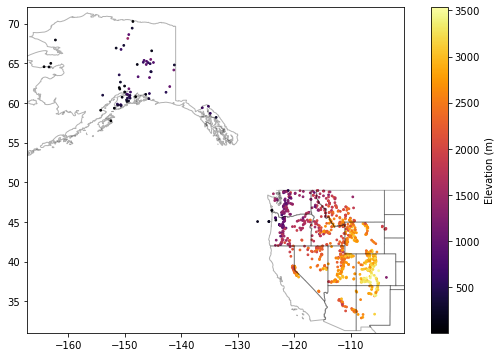
Exclude the Alaska (AK) points to isolate points over Western U.S.¶
Simple appraoch is to remove points where the site name contains ‘AK’ with attribute filter
Note the number of records
sites_gdf_conus = sites_gdf_all[~(sites_gdf_all.index.str.contains('AK'))]
Alternatively, can use a spatial filter (see GeoPandas
cxindexer functionality for a bounding box)
#xmin, xmax, ymin, ymax = [-126, 102, 30, 50]
#sites_gdf_conus = sites_gdf_all.cx[xmin:xmax, ymin:ymax]
sites_gdf_conus.shape
(865, 6)
Update your scatterplot as sanity check¶
Should look something like the Western U.S.
f, ax = plt.subplots(figsize=(10,6))
sites_gdf_conus.plot(ax=ax, column='elevation_m', markersize=3, cmap='inferno', legend=True, legend_kwds={'label': "Elevation (m)"})
ax.autoscale(False)
states_gdf.plot(ax=ax, facecolor='none', edgecolor='k', alpha=0.3);
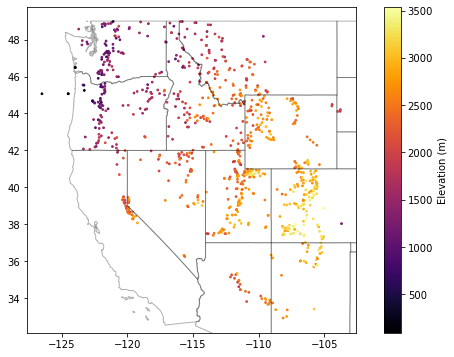
Export SNOTEL site GeoDataFrame as a geojson¶
Maybe useful for other purposes, and can avoid all of the above processing, just load directly with geopandas
read_file
sites_gdf_conus.to_file?
sites_fn = 'snotel_conus_sites.json'
if not os.path.exists(sites_fn):
sites_gdf_conus.to_file(sites_fn, driver='GeoJSON')
Part 2: Spatial filter points by polygon¶
Load Grand Mesa Polygon¶
gm_poly_fn = 'grand_mesa_poly.geojson'
gm_poly_gdf = gpd.read_file(gm_poly_fn)
gm_poly_gdf.plot()
<AxesSubplot:>
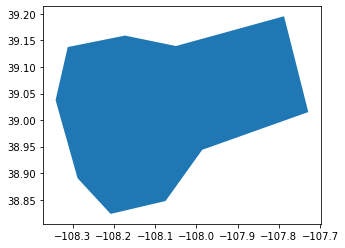
A quick aside on geometry objects¶
Vector data contain geometry objects¶
Classes (Point, Line, Polygon) with unique attribute and methods
Polygon vs. MultiPolygon
https://automating-gis-processes.github.io/site/notebooks/L1/geometric-objects.html
https://shapely.readthedocs.io/en/stable/manual.html#geometric-objects
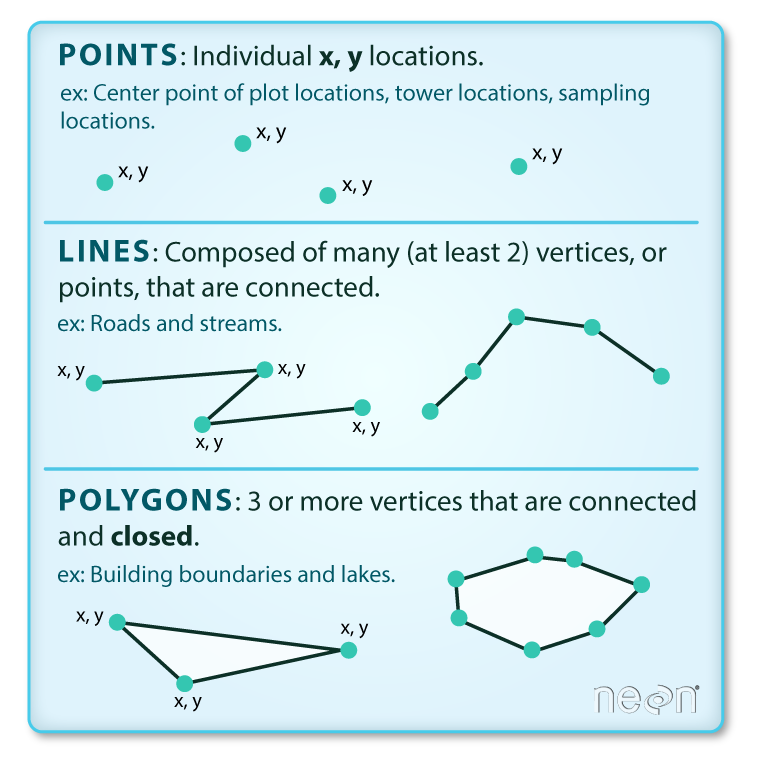 Image Source: National Ecological Observatory Network (NEON), from https://datacarpentry.org/organization-geospatial
Image Source: National Ecological Observatory Network (NEON), from https://datacarpentry.org/organization-geospatial
Isolate Polygon geometry within GeoDataFrame¶
type(gm_poly_gdf)
geopandas.geodataframe.GeoDataFrame
gm_poly_gdf
| geometry | |
|---|---|
| 0 | POLYGON ((-108.31168 39.13758, -108.34116 39.0... |
gm_poly_gdf.total_bounds
array([-108.34115668, 38.82320553, -107.72839859, 39.19563035])
gm_poly_gdf.iloc[0] #Now a GeoSeries
geometry POLYGON ((-108.31168 39.13758, -108.34116 39.0...
Name: 0, dtype: geometry
gm_poly_geom = gm_poly_gdf.iloc[0].geometry
gm_poly_geom
print(gm_poly_geom)
POLYGON ((-108.3116825655377 39.13757646212944, -108.3411566832522 39.03758987613325, -108.2878686387796 38.89051431295789, -108.2077296878005 38.8232055291981, -108.0746016431103 38.8475137825863, -107.9856051049498 38.9439912011017, -107.7283985875575 39.01510930230633, -107.7872414249099 39.19563034965999, -108.0493948009875 39.13950466335424, -108.1728700097086 39.15920066396116, -108.3116825655377 39.13757646212944))
list(gm_poly_geom.exterior.coords)
[(-108.31168256553767, 39.13757646212944),
(-108.34115668325224, 39.03758987613325),
(-108.2878686387796, 38.89051431295789),
(-108.20772968780051, 38.8232055291981),
(-108.07460164311031, 38.8475137825863),
(-107.98560510494981, 38.9439912011017),
(-107.72839858755752, 39.01510930230633),
(-107.78724142490994, 39.195630349659986),
(-108.04939480098754, 39.139504663354245),
(-108.17287000970857, 39.15920066396116),
(-108.31168256553767, 39.13757646212944)]
gm_poly_geom.bounds
(-108.34115668325224,
38.8232055291981,
-107.72839858755752,
39.195630349659986)
Generate boolean index for points that intersect the polygon¶
This will return a new GeoDataSeries with True/False values for each record
idx = sites_gdf_all.intersects(gm_poly_geom)
idx.head()
SNOTEL:301_CA_SNTL False
SNOTEL:907_UT_SNTL False
SNOTEL:916_MT_SNTL False
SNOTEL:1267_AK_SNTL False
SNOTEL:908_WA_SNTL False
dtype: bool
idx.value_counts()
False 928
True 2
dtype: int64
Use fancy indexing to isolate points and return new GeoDataFrame¶
gm_snotel_sites = sites_gdf_all.loc[idx]
gm_snotel_sites
| code | name | network | elevation_m | site_property | geometry | |
|---|---|---|---|---|---|---|
| SNOTEL:622_CO_SNTL | 622_CO_SNTL | Mesa Lakes | SNOTEL | 3048.000000 | {'county': 'Mesa', 'state': 'Colorado', 'site_... | POINT (-108.05835 39.05831) |
| SNOTEL:682_CO_SNTL | 682_CO_SNTL | Park Reservoir | SNOTEL | 3035.808105 | {'county': 'Delta', 'state': 'Colorado', 'site... | POINT (-107.87414 39.04644) |
Quick plot¶
f, ax = plt.subplots(figsize=(10,6))
gm_snotel_sites.plot(ax=ax, column='elevation_m', markersize=20, edgecolor='k', cmap='inferno', \
legend=True, legend_kwds={'label':'Elevation (m)'})
#ctx.add_basemap(ax=ax, crs=gm_snotel_sites.crs, source=ctx.providers.Stamen.Terrain)
ax.set_title('Grand Mesa SNOTEL Stations');
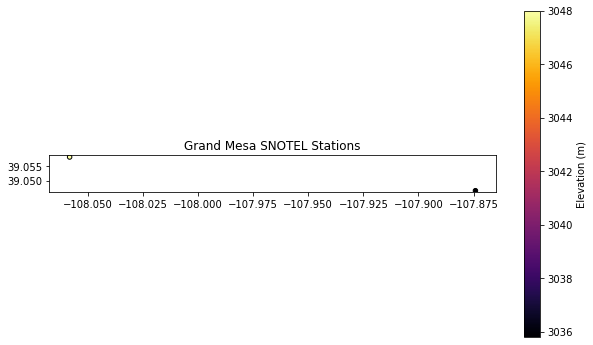
import hvplot.pandas
from geoviews import tile_sources as gvts
gm_snotel_sites.hvplot(hover_cols=['index','name']) * gm_poly_gdf.to_crs(gm_snotel_sites.crs).hvplot(color='none')
Add a basemap¶
This functionality will add a publicly available tiled basemap to your interactive holoviews plot, which is useful for context during interactive visualization.
Note that we need to reproject our GeoDataframe to match the CRS of the tiled basemap here.
For static plots with matplotlib (e.g., for publication) can also use contextily for this https://contextily.readthedocs.io/en/latest/
map_tiles = gvts.EsriImagery
map_tiles * gm_snotel_sites.to_crs('EPSG:3857').hvplot(hover_cols=['index','name']) * \
gm_poly_gdf.to_crs('EPSG:3857').hvplot(color='none')
Part 3: Time series analysis for one station¶
Now that we’ve identified sites of interest, let’s query the API to obtain the time series data for variables of interest (snow!).
https://wcc.sc.egov.usda.gov/nwcc/site?sitenum=622&state=co
sitecode = gm_snotel_sites.index[-1]
sitecode
'SNOTEL:682_CO_SNTL'
Get available measurements for this site¶
Note that there are many standard meteorological variables that can be downloaded for this site, in addition to the snow depth and snow water equivalent.
ulmo.cuahsi.wof.get_site_info(wsdlurl, sitecode)['series'].keys()
dict_keys(['SNOTEL:BATT_D', 'SNOTEL:BATT_H', 'SNOTEL:BATX_H', 'SNOTEL:PRCP_y', 'SNOTEL:PRCP_sm', 'SNOTEL:PRCP_m', 'SNOTEL:PRCP_wy', 'SNOTEL:PRCPSA_y', 'SNOTEL:PRCPSA_D', 'SNOTEL:PRCPSA_sm', 'SNOTEL:PRCPSA_m', 'SNOTEL:PRCPSA_wy', 'SNOTEL:PREC_sm', 'SNOTEL:PREC_m', 'SNOTEL:PREC_wy', 'SNOTEL:SNWD_D', 'SNOTEL:SNWD_sm', 'SNOTEL:SNWD_H', 'SNOTEL:SNWD_m', 'SNOTEL:TAVG_y', 'SNOTEL:TAVG_D', 'SNOTEL:TAVG_sm', 'SNOTEL:TAVG_m', 'SNOTEL:TAVG_wy', 'SNOTEL:TMAX_y', 'SNOTEL:TMAX_D', 'SNOTEL:TMAX_sm', 'SNOTEL:TMAX_m', 'SNOTEL:TMAX_wy', 'SNOTEL:TMIN_y', 'SNOTEL:TMIN_D', 'SNOTEL:TMIN_sm', 'SNOTEL:TMIN_m', 'SNOTEL:TMIN_wy', 'SNOTEL:TOBS_D', 'SNOTEL:TOBS_sm', 'SNOTEL:TOBS_H', 'SNOTEL:TOBS_m', 'SNOTEL:WTEQ_D', 'SNOTEL:WTEQ_sm', 'SNOTEL:WTEQ_H', 'SNOTEL:WTEQ_m'])
_H = “hourly”
_D = “daily”
_sm, _m = “monthly”
Let’s consider the ‘SNOTEL:SNWD_D’ variable (Daily Snow Depth)¶
Assign ‘SNOTEL:SNWD_D’ to a variable named
variablecodeGet some information about the variable using
get_variable_infomethodNote the units, nodata value, etc.
Note: The snow depth records are almost always shorter/noisier than the SWE records for SNOTEL sites
#Daily SWE
#variablecode = 'SNOTEL:WTEQ_D'
#Daily snow depth
variablecode = 'SNOTEL:SNWD_D'
#Hourly SWE
#variablecode = 'SNOTEL:WTEQ_H'
#Hourly snow depth
#variablecode = 'SNOTEL:SNWD_H'
ulmo.cuahsi.wof.get_variable_info(wsdlurl, variablecode)
{'value_type': 'Field Observation',
'data_type': 'Continuous',
'general_category': 'Soil',
'sample_medium': 'Snow',
'no_data_value': '-9999',
'speciation': 'Not Applicable',
'code': 'SNWD_D',
'id': '176',
'name': 'Snow depth',
'vocabulary': 'SNOTEL',
'time': {'is_regular': True,
'interval': '1',
'units': {'abbreviation': 'd',
'code': '104',
'name': 'day',
'type': 'Time'}},
'units': {'abbreviation': 'in',
'code': '49',
'name': 'international inch',
'type': 'Length'}}
Define a function to fetch data¶
I’ve done this for you, but please review the comments and steps to see what is going on under the hood
You’ll probably have to do similar data wrangling for another project at some point in the future
#Get current datetime
today = datetime.today().strftime('%Y-%m-%d')
def snotel_fetch(sitecode, variablecode='SNOTEL:SNWD_D', start_date='1950-10-01', end_date=today):
#print(sitecode, variablecode, start_date, end_date)
values_df = None
try:
#Request data from the server
site_values = ulmo.cuahsi.wof.get_values(wsdlurl, sitecode, variablecode, start=start_date, end=end_date)
#Convert to a Pandas DataFrame
values_df = pd.DataFrame.from_dict(site_values['values'])
#Parse the datetime values to Pandas Timestamp objects
values_df['datetime'] = pd.to_datetime(values_df['datetime'], utc=True)
#Set the DataFrame index to the Timestamps
values_df = values_df.set_index('datetime')
#Convert values to float and replace -9999 nodata values with NaN
values_df['value'] = pd.to_numeric(values_df['value']).replace(-9999, np.nan)
#Remove any records flagged with lower quality
values_df = values_df[values_df['quality_control_level_code'] == '1']
except:
print("Unable to fetch %s" % variablecode)
return values_df
Use this function to get the full ‘SNOTEL:SNWD_D’ record for one station¶
Inspect the results
We used a dummy start date of Jan 1, 1950. What is the actual the first date returned?
#Get all records, can filter later
start_date = datetime(1950,1,1)
end_date = datetime.today()
print(sitecode)
values_df = snotel_fetch(sitecode, variablecode, start_date, end_date)
values_df.shape
SNOTEL:682_CO_SNTL
(8980, 8)
values_df.head()
| value | qualifiers | censor_code | date_time_utc | method_id | method_code | source_code | quality_control_level_code | |
|---|---|---|---|---|---|---|---|---|
| datetime | ||||||||
| 1997-03-21 00:00:00+00:00 | 71.0 | V | nc | 1997-03-21T00:00:00 | 0 | 0 | 1 | 1 |
| 1997-03-22 00:00:00+00:00 | 70.0 | V | nc | 1997-03-22T00:00:00 | 0 | 0 | 1 | 1 |
| 1997-03-23 00:00:00+00:00 | 69.0 | V | nc | 1997-03-23T00:00:00 | 0 | 0 | 1 | 1 |
| 1997-03-24 00:00:00+00:00 | 68.0 | V | nc | 1997-03-24T00:00:00 | 0 | 0 | 1 | 1 |
| 1997-03-25 00:00:00+00:00 | 68.0 | V | nc | 1997-03-25T00:00:00 | 0 | 0 | 1 | 1 |
#Get number of decimal years between first and last observation
nyears = (values_df.index.max() - values_df.index.min()).days/365.25
nyears
24.583162217659137
Create a quick plot to view the time series¶
Take a moment to inspect the
valuecolumn, which is where theSNWD_Dvalues are storedSanity check thought question: What are the units again?
values_df.hvplot()
Compute the integer day of year (doy) and integer day of water year (dowy)¶
Can get doy for each record with
df.index.dayofyearCan compute on the fly, but add a new column to store these values
https://pandas.pydata.org/pandas-docs/version/0.19/generated/pandas.DatetimeIndex.dayofyear.html
For the day of water year, you’ll need to offset by 9 months, then compute day of year
Add another column to store these values
#Add DOY and DOWY column
#Need to revisit for leap year support
def add_dowy(df, col=None):
if col is None:
df['doy'] = df.index.dayofyear
else:
df['doy'] = df[col].dayofyear
# Sept 30 is doy 273
df['dowy'] = df['doy'] - 273
df.loc[df['dowy'] <= 0, 'dowy'] += 365
add_dowy(values_df)
Compute statistics for each day of the water year, using values from all years¶
Seems like a Pandas groupby/agg might work here
Stats should at least include min, max, mean, and median
stat_list = ['count','min','max','mean','std','median','mad']
doy_stats = values_df.groupby('dowy').agg(stat_list)['value']
doy_stats
| count | min | max | mean | std | median | mad | |
|---|---|---|---|---|---|---|---|
| dowy | |||||||
| 1 | 21 | 0.0 | 1.0 | 0.095238 | 0.300793 | 0.0 | 0.172336 |
| 2 | 21 | 0.0 | 3.0 | 0.285714 | 0.783764 | 0.0 | 0.489796 |
| 3 | 21 | 0.0 | 6.0 | 0.714286 | 1.454058 | 0.0 | 0.952381 |
| 4 | 21 | 0.0 | 10.0 | 0.952381 | 2.459191 | 0.0 | 1.360544 |
| 5 | 21 | 0.0 | 7.0 | 0.761905 | 1.700140 | 0.0 | 1.015873 |
| ... | ... | ... | ... | ... | ... | ... | ... |
| 361 | 20 | 0.0 | 4.0 | 0.400000 | 0.994723 | 0.0 | 0.640000 |
| 362 | 20 | 0.0 | 2.0 | 0.200000 | 0.523148 | 0.0 | 0.340000 |
| 363 | 20 | 0.0 | 2.0 | 0.200000 | 0.523148 | 0.0 | 0.340000 |
| 364 | 20 | 0.0 | 2.0 | 0.200000 | 0.523148 | 0.0 | 0.340000 |
| 365 | 20 | 0.0 | 1.0 | 0.050000 | 0.223607 | 0.0 | 0.095000 |
365 rows × 7 columns
Create a plot of these aggregated dowy values¶
Something like the 30-year mean and median here: https://www.nwrfc.noaa.gov/snow/plot_SWE.php?id=AFSW1
f,ax = plt.subplots(figsize=(10,5))
for stat in ['min','max','mean','median']:
ax.plot(doy_stats.index, doy_stats[stat], label=stat)
ax.fill_between(doy_stats.index, doy_stats['mean'] - doy_stats['std'], doy_stats['mean'] + doy_stats['std'], \
color='lightgrey', label='1-std')
title = f'{sitecode}: \n{values_df.index.min().date()} to {values_df.index.max().date()} ({nyears:.2f} years)'
ax.set_title(title)
ax.set_xlabel('Day of Water Year (Oct 1)')
ax.set_ylabel('Snow depth (in)')
ax.grid()
ax.legend()
ax.set_xlim(0,366)
ax.set_ylim(bottom=0);
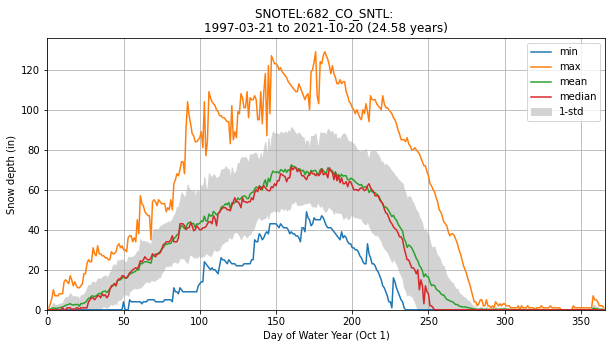
Add the daily snow depth values for the current water year¶
Can use pandas indexing here with simple strings (‘YYYY-MM-DD’), or Timestamp objects
Standard slicing also works with
:
Make sure to
dropnato remove any records missing dataAdd this to your plot
#Define variable to store current year
curr_y = datetime.now().year
curr_y
2021
#df_wy = values_df.loc['2019-10-1':].dropna()
df_wy = values_df.loc[f'{curr_y-1}-10-1':].dropna()
f,ax = plt.subplots(figsize=(10,5))
for stat in ['min','max','mean','median']:
ax.plot(doy_stats.index, doy_stats[stat], label=stat)
ax.fill_between(doy_stats.index, doy_stats['mean'] - doy_stats['std'], doy_stats['mean'] + doy_stats['std'], \
color='lightgrey', label='1-std')
ax.set_title(title)
ax.set_xlabel('Day of Water Year')
ax.set_ylabel('Snow depth (in)')
ax.grid()
ax.plot(df_wy['dowy'], df_wy['value'], marker='.', color='k', ls='none', label='Current WY')
ax.legend()
ax.set_xlim(0,366)
ax.set_ylim(bottom=0);
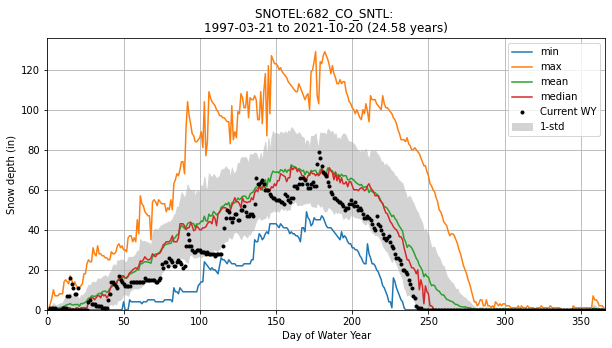
What was the percentage of “normal” snow depth on April 1 of this year?¶
Can use long-term median for this dowy
df_wy.loc[f'{curr_y}-4-1']
value 67.0
qualifiers V
censor_code nc
date_time_utc 2021-04-01T00:00:00
method_id 0
method_code 0
source_code 1
quality_control_level_code 1
doy 91
dowy 183
Name: 2021-04-01 00:00:00+00:00, dtype: object
apr1_doy = df_wy.loc[f'{curr_y}-4-1']['dowy']
apr1_doy
183
doy_stats.loc[apr1_doy]
count 24.000000
min 42.000000
max 127.000000
mean 68.291667
std 18.892094
median 68.000000
mad 13.375000
Name: 183, dtype: float64
#Percent of normal
perc_normal = 100 * df_wy.loc[f'{curr_y}-4-1']['value']/doy_stats.loc[apr1_doy]['median']
print(f'{perc_normal:0.2f}% percent of normal snow depth on DOWY {apr1_doy} in {curr_y}')
98.53% percent of normal snow depth on DOWY 183 in 2021
Index DataFrame by date or date range¶
Maybe useful for project work
dt1 = '2017-2-1'
dt2 = '2017-2-4'
#Single date
values_df.loc[dt1]
value 77.0
qualifiers V
censor_code nc
date_time_utc 2017-02-01T00:00:00
method_id 0
method_code 0
source_code 1
quality_control_level_code 1
doy 32
dowy 124
Name: 2017-02-01 00:00:00+00:00, dtype: object
values_df.loc[dt1]['value']
77.0
values_df.loc[dt1:dt2]
| value | qualifiers | censor_code | date_time_utc | method_id | method_code | source_code | quality_control_level_code | doy | dowy | |
|---|---|---|---|---|---|---|---|---|---|---|
| datetime | ||||||||||
| 2017-02-01 00:00:00+00:00 | 77.0 | V | nc | 2017-02-01T00:00:00 | 0 | 0 | 1 | 1 | 32 | 124 |
| 2017-02-02 00:00:00+00:00 | 76.0 | V | nc | 2017-02-02T00:00:00 | 0 | 0 | 1 | 1 | 33 | 125 |
| 2017-02-03 00:00:00+00:00 | 76.0 | V | nc | 2017-02-03T00:00:00 | 0 | 0 | 1 | 1 | 34 | 126 |
| 2017-02-04 00:00:00+00:00 | 75.0 | V | nc | 2017-02-04T00:00:00 | 0 | 0 | 1 | 1 | 35 | 127 |
Query multiple sites¶
Can use a loop to query multiple sites and/or variables
#Define an empty dictionary to store returns for each site
value_dict = {}
for i, sitecode in enumerate(gm_snotel_sites.index):
print('%i of %i sites: %s' % (i+1, len(gm_snotel_sites.index), sitecode))
out = snotel_fetch(sitecode, variablecode)
if out is not None:
value_dict[sitecode] = out['value']
#Convert the dictionary to a DataFrame, automatically handles different datetime ranges (nice!)
multi_df = pd.DataFrame.from_dict(value_dict)
1 of 2 sites: SNOTEL:622_CO_SNTL
2 of 2 sites: SNOTEL:682_CO_SNTL
multi_df
| SNOTEL:622_CO_SNTL | SNOTEL:682_CO_SNTL | |
|---|---|---|
| datetime | ||
| 1997-03-21 00:00:00+00:00 | NaN | 71.0 |
| 1997-03-22 00:00:00+00:00 | NaN | 70.0 |
| 1997-03-23 00:00:00+00:00 | NaN | 69.0 |
| 1997-03-24 00:00:00+00:00 | NaN | 68.0 |
| 1997-03-25 00:00:00+00:00 | NaN | 68.0 |
| ... | ... | ... |
| 2021-10-16 00:00:00+00:00 | 8.0 | 13.0 |
| 2021-10-17 00:00:00+00:00 | 8.0 | 11.0 |
| 2021-10-18 00:00:00+00:00 | 5.0 | 8.0 |
| 2021-10-19 00:00:00+00:00 | NaN | 8.0 |
| 2021-10-20 00:00:00+00:00 | NaN | 11.0 |
8980 rows × 2 columns
multi_df.hvplot()
#Hack to remove bad measurements
multi_df[multi_df > 190] = np.nan
multi_df.hvplot()
Scatterplot to compare corresponding values¶
multi_df.dropna().hvplot(kind='scatter', x='SNOTEL:622_CO_SNTL', y='SNOTEL:682_CO_SNTL', \
aspect='equal', s=1)
Determine Pearson’s correlation coefficient for the two time series¶
https://en.wikipedia.org/wiki/Pearson_correlation_coefficient
See the Pandas
corrmethodThis should properly handle nan under the hood!
multi_df.corr()
| SNOTEL:622_CO_SNTL | SNOTEL:682_CO_SNTL | |
|---|---|---|
| SNOTEL:622_CO_SNTL | 1.000000 | 0.968504 |
| SNOTEL:682_CO_SNTL | 0.968504 | 1.000000 |
Highly correlated snow depth records for these two sites!
